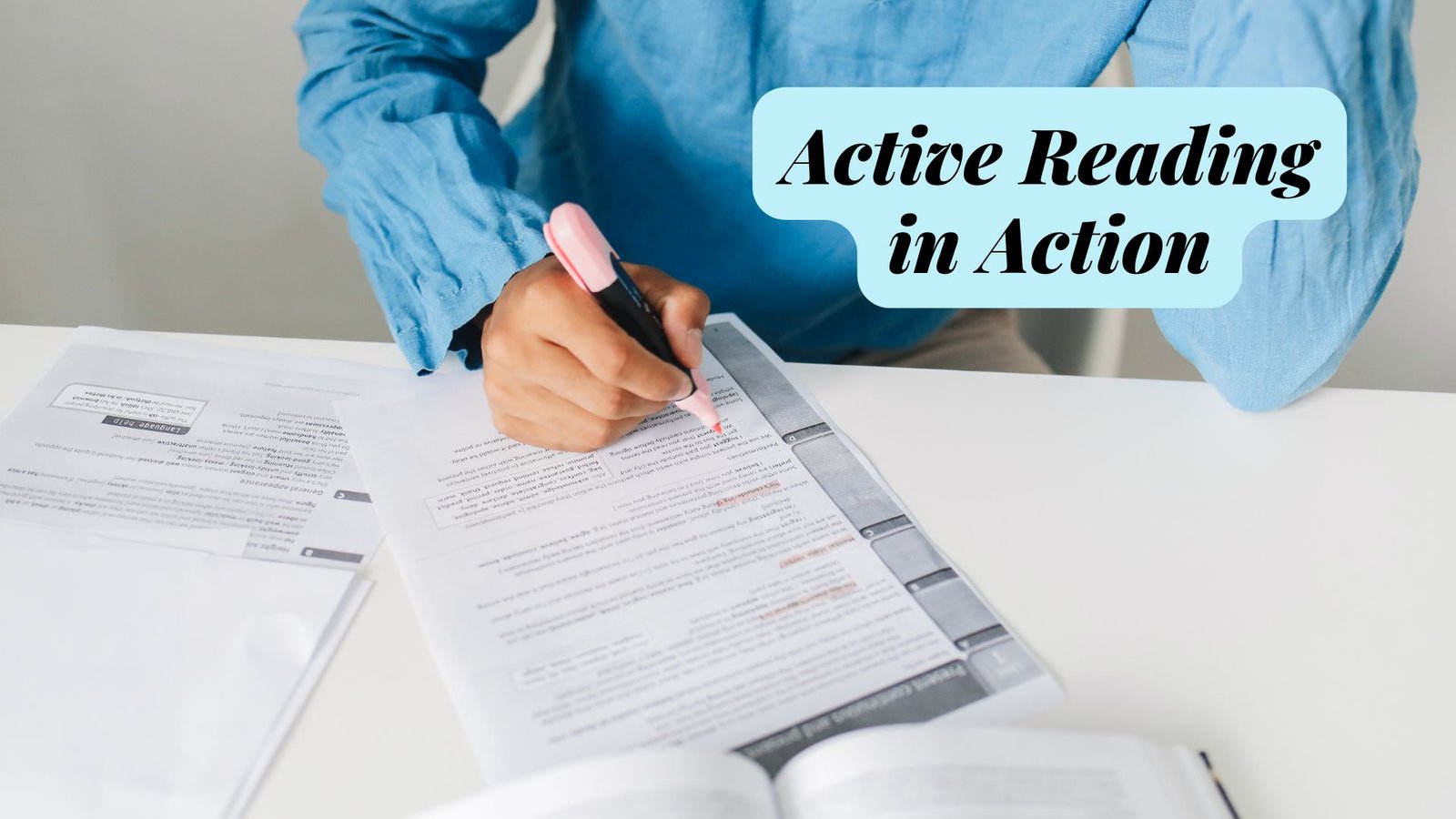Have you ever watched a master chef transform simple ingredients into a gourmet dish?
Active reading does the same for words—turning passive skimming into a rich, engaging experience that deepens understanding and locks knowledge into memory.
While most people know they should highlight or take notes, true active reading goes far beyond these basics. It’s about interrogating texts, visualizing concepts, and connecting ideas—strategies proven to improve retention by up to 75% compared to passive reading.
But what does this look like in practice?
From students dissecting Hamlet to executives speed-reading reports, here are 7 powerful examples of active reading techniques—backed by research and real-world success stories.
1. The Textbook Strategist: SQ3R in Action
Scenario: A college student tackling a dense biology chapter on cellular respiration.
Active Reading Approach:
- Survey: Scans headings, diagrams, and summary questions first.
- Question: Converts section titles into queries (“How does ATP store energy?”).
- Read: Seeks answers, annotating key terms like “Krebs cycle”with analogies (“Like a cellular power plant”).
- Recite: Covers the text and explains concepts aloud using simple language.
- Review: Revisits annotations and creates a mind map before class.
Result:
- Retains 50% more than peers who just re-read.
- Aces exam questions by recalling self-generated Q&A.
2. The Novel Explorer: Annotation + Character Mapping
Scenario: A book club member analyzing The Great Gatsby.
Active Reading Approach:
- Marginalia: Jots reactions (“Daisy’s voice ‘full of money’—is Gatsby in love or obsessed with status?”).
- Symbol Tracking: Highlights all “green light” references to trace symbolism.
- Character Webs: Draws connections between Gatsby, Tom, and Nick, noting power dynamics.
Result:
- Uncovers subtle themes (e.g., “The American Dream as a mirage”).
- Leads a lively discussion with textual evidence.
3. The Executive Skimmer: Strategic Highlighting
Scenario: A CEO reviewing a 50-page market analysis.
Active Reading Approach:
- 20% Rule: Highlights only 1–2 key lines per page (e.g., “Competitor X’s market share dropped 12%”).
- Margin Codes: Uses symbols:
- ! = Urgent action
- ? = Needs clarification
- → = Follow-up task.
Result:
- Cuts reading time by 30% while capturing critical insights.
- Delegates tasks efficiently using coded notes.
4. The Research Power-Reader: Hexagonal Thinking
Scenario: A scientist synthesizing 20 journal articles on climate change.
Active Reading Approach:
- Color-Coded Notes:
- Blue = Methods
- Red = Contradictory findings
- Hexagonal Thinking: Physically links related ideas (e.g., ties “ocean acidification” to “coral bleaching”).
Result:
- Identifies research gaps faster.
- Publishes a meta-analysis with novel connections.
5. The Language Learner: Multisensory Notes
Scenario: A student mastering French with Le Petit Prince.
Active Reading Approach:
- KAVE COGS: Engages all senses:
- Kinesthetic: Underlines verbs while tapping their foot to the rhythm.
- Auditory: Listens to an audiobook version for pronunciation.
- Visual: Draws scenes (e.g., the boa constrictor digesting an elephant).
- Vocabulary Journal: Records new words with doodles (“mouton” = sheep with cartoon wool) 8.
Result:
- Doubles vocabulary retention vs. flashcards alone.
- Develops an intuitive grasp of grammar.
6. The Exam Crammer: Cornell + Self-Quizzing
Scenario: A law student prepping for the bar exam.
Active Reading Approach:
- Cornell Notes: Divides pages into:
- Key Terms (left column)
- Case Summaries (right)
- Self-Test Prompts (bottom).
- Teach It Back: Explains Miranda v. Arizona to a study partner in 60 seconds.
Result:
- Scores 15% higher on practice tests.
- Avoids “illusion of competence” from passive re-reading.
7. The Parent-Child Duo: Interactive Storytime
Scenario: A parent reading Charlotte’s Web with a 7-year-old.
Active Reading Approach:
- Predictions: Pauses to ask, “What will Wilbur do next?”
- Voice Acting: Uses different tones for Charlotte (“wise”) and Templeton (“grumpy”).
- Real-World Links: Relates Wilbur’s loneliness to the child’s first day at school 6.
Result:
- Child’s reading comprehension improves 40% on standardized tests.
- Fosters a lifelong love of books.
Key Lessons From These Examples
- Active reading is customizable—adapt techniques to your goal (speed vs. depth).
- Multisensory engagement wins—combine writing, speaking, and visualizing.
- Less is more—highlight sparingly, annotate purposefully.
Your Challenge: Try One Technique Today
Pick one example above and apply it to your next reading session. Notice how much sharper your focus—and recall—becomes.
💬 Now I’d love to hear: Which active reading tactic resonates most with you? Share your experiences below!
Also Read:
How Active Reading Can Improve Your Comprehension
Active Reading The Layered Approach
Sources & Further Reading
- McGraw Center: Annotation & Cornell Notes
- Open University: SQ3R Method
- Rhodes College: 10 Active Reading Tips
Loved this? Share with someone who “reads but doesn’t remember”! 📚✨

